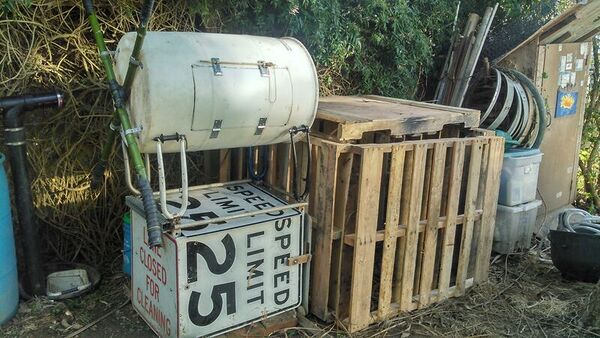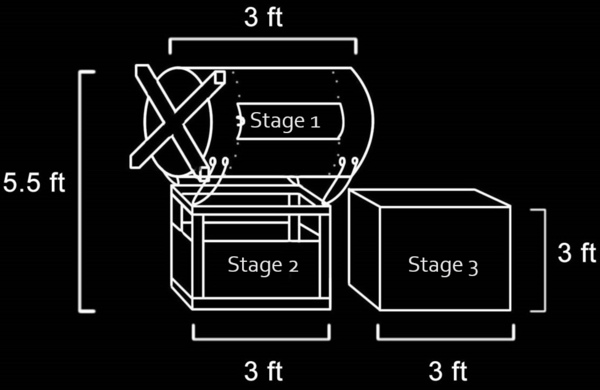| Line 55: | Line 55: | ||
[[Image:FinalCompostDesign.png|thumb|upright=2|center|Fig 2: Final Design for the Three Stage Composter]] | [[Image:FinalCompostDesign.png|thumb|upright=2|center|Fig 2: Final Design for the Three Stage Composter]] | ||
<gallery> | |||
[[Image:FinalCompostDesign.png|thumb|upright=2|left|Fig 3: Final Design for the Three Stage Composter]] | [[Image:FinalCompostDesign.png|thumb|upright=2|left|Fig 3: Final Design for the Three Stage Composter]] | ||
| Line 72: | Line 72: | ||
[[Image:FinalCompostDesign.png|thumb|upright=2|right|Fig 4: Final Design for the Three Stage Composter]] | [[Image:FinalCompostDesign.png|thumb|upright=2|right|Fig 4: Final Design for the Three Stage Composter]] | ||
</gallery> | |||
=== Costs === | === Costs === | ||
Revision as of 01:18, 9 December 2016

Abstract
The "Three Stage Rotating System" is the design that was chosen for the improved compost system at the sanctuary. Members of the Sanctuary want an improved compost system that will be more aesthetically pleasing, desirable, and easy to use. The project should also include improvements in rat-proofing and weather resistance. Additional requirements include low embedded energy of materials, preferably reused and re purposed materials.
Background
Team Compost was created in the Fall of 2016 at the Humboldt State University's Engineering 215 class. Our client for the ENGR 215 class was The Sanctuary, a creative space for artists and people from the Humboldt community to use tools, take music classes, participate in community events, or teach a skill. A primary interest of the Sanctuary crew was sustainable living and design, so much of their yard was devoted to gardening, building, or composting. Because their old compost system was a do-it-yourself mash-up of an old metal pipe and some trash cans, the process was fairly inefficient and had the added problem of infestation by rats.
Problem statement and criteria
Team Compost's objective was to improve the Sanctuary's compost system by making the design inviting, accessible and rat-proof. The previous compost system was composed of two metal trash cans that were leaking and wet, and a finishing bin that was an old metal rusty container with a non functional lid. The project aimed to upgrade the Sanctuary's old system into a functional composter that is easy to use, easy to maintain, aesthetically pleasing and easily accessible, for a price not to exceed $400. The final design was dubbed the "Three Stage Rotating System."
Team Compost used a set of weighted criteria to best fit the design process to the Sanctuary's needs. The new compost system had to satisfy all criteria in order to last for multiple years. See below for a table that organizes the weighted criteria.
| Criteria | Importance | Constraints |
|---|---|---|
| Ease of Use | 7 | The system's use is readily apparent and easily done by most people. |
| Durability | 10 | The improved compost system should last at least two years. |
| Ease of Maintenance | 9 | Requires little to no maintenance on the part of the owners. |
| Pest-Resistance | 8 | Must keep away pests and rats. |
| Cost | 5 | Cost must not exceed $400: $100 provided by the client and $75 per team member. |
| Aesthetics | 4 | The system must look inviting enough for people to want to interact with it. |
| Accessibility | 6 | Accessible for people of most heights, ages, and ability levels. |
Description of final project
The final design met the criteria in a lasting, and effective way. Because the Sanctuary's old compost system was prone to rats, succumbing to the weather, and difficult to use, the new system had to be made of more durable materials while existing in a configuration that would repel invasion by pests. In response to these problems, the team formulated the "Three Stage Rotating System" design. The final configuration was comprised of a 55 gallon drum resting on rollers above a metal frame housing a secondary composting bin. A larger storage bin, made of wood palates, was located adjacent to the second stage. The rotating bin design solved two problems at once by elevating the freshest food-waste materials away from access by rats, and by allowing for easy turning and aeration of the compost. The rotating element was extremely important to the team and the client because stirring compost materials frequently can greatly aid in the efficiency of their break-down. Once material in the first stage was broken down enough it could easily be dumped directly into the second stage below, where it would finish decomposition before being transferred to the third stage storage bin.

Costs
The table below lists materials used on the project and component costs.
| Quantity | Material | Source | Cost ($) | Total ($) |
|---|---|---|---|---|
| 1 | Scrap metal street post(Telespar) | Donated | 0.00 | 0.00 |
| 1 | 55 Gallon Barrel | Donated | 0.00 | 0.00 |
| 4 | Bicycle Forks | The Bike library | 10.00 | 40.00 |
| 4 | Bicycle Hubs | Donated | 0.00 | 0.00 |
| 5 | Road Signs | Arcata Scrap | 37.00 | 37.00 |
| 5 | Wood Pallets | Donated | 0.00 | 0.00 |
| 84 | Machine Screws | Ace Hardware | 00.30 | 25.20 |
| 60 | Washers | Ace Hardware | 00.25 | 15.00 |
| 2 | Hasp | Ace Hardware | 05.20 | 10.40 |
| 3 | Hinge | Ace Hardware | 07.00 | 21.00 |
| 30 | Nuts | Ace Hardware | 00.30 | 9.00 |
| Total Cost | $157.60 | |||